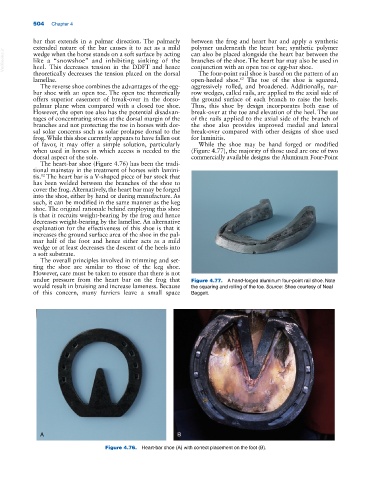Page 538 - Adams and Stashak's Lameness in Horses, 7th Edition
P. 538
504 Chapter 4
bar that extends in a palmar direction. The palmarly between the frog and heart bar and apply a synthetic
extended nature of the bar causes it to act as a mild polymer underneath the heart bar; synthetic polymer
VetBooks.ir like a “snowshoe” and inhibiting sinking of the branches of the shoe. The heart bar may also be used in
can also be placed alongside the heart bar between the
wedge when the horse stands on a soft surface by acting
conjunction with an open toe or egg‐bar shoe.
heel. This decreases tension in the DDFT and hence
theoretically decreases the tension placed on the dorsal The four‐point rail shoe is based on the pattern of an
lamellae. open‐heeled shoe. The toe of the shoe is squared,
62
The reverse shoe combines the advantages of the egg‐ aggressively rolled, and broadened. Additionally, nar-
bar shoe with an open toe. The open toe theoretically row wedges, called rails, are applied to the axial side of
offers superior easement of break‐over in the dorso- the ground surface of each branch to raise the heels.
palmar plane when compared with a closed toe shoe. Thus, this shoe by design incorporates both ease of
However, the open toe also has the potential disadvan- break‐over at the toe and elevation of the heel. The use
tages of concentrating stress at the dorsal margin of the of the rails applied to the axial side of the branch of
branches and not protecting the toe in horses with dor- the shoe also provides improved medial and lateral
sal solar concerns such as solar prolapse dorsal to the break‐over compared with other designs of shoe used
frog. While this shoe currently appears to have fallen out for laminitis.
of favor, it may offer a simple solution, particularly While the shoe may be hand forged or modified
when used in horses in which access is needed to the (Figure 4.77), the majority of those used are one of two
dorsal aspect of the sole. commercially available designs: the Aluminum Four‐Point
The heart‐bar shoe (Figure 4.76) has been the tradi-
tional mainstay in the treatment of horses with lamini-
12
tis. The heart bar is a V‐shaped piece of bar stock that
has been welded between the branches of the shoe to
cover the frog. Alternatively, the heart bar may be forged
into the shoe, either by hand or during manufacture. As
such, it can be modified in the same manner as the keg
shoe. The original rationale behind employing this shoe
is that it recruits weight‐bearing by the frog and hence
decreases weight‐bearing by the lamellae. An alternative
explanation for the effectiveness of this shoe is that it
increases the ground surface area of the shoe in the pal-
mar half of the foot and hence either acts as a mild
wedge or at least decreases the descent of the heels into
a soft substrate.
The overall principles involved in trimming and set-
ting the shoe are similar to those of the keg shoe.
However, care must be taken to ensure that there is not
undue pressure from the heart bar on the frog that Figure 4.77. A hand‐forged aluminum four‐point rail shoe. Note
would result in bruising and increase lameness. Because the squaring and rolling of the toe. Source: Shoe courtesy of Neal
of this concern, many farriers leave a small space Baggett.
A B
Figure 4.76. Heart‐bar shoe (A) with correct placement on the foot (B).

